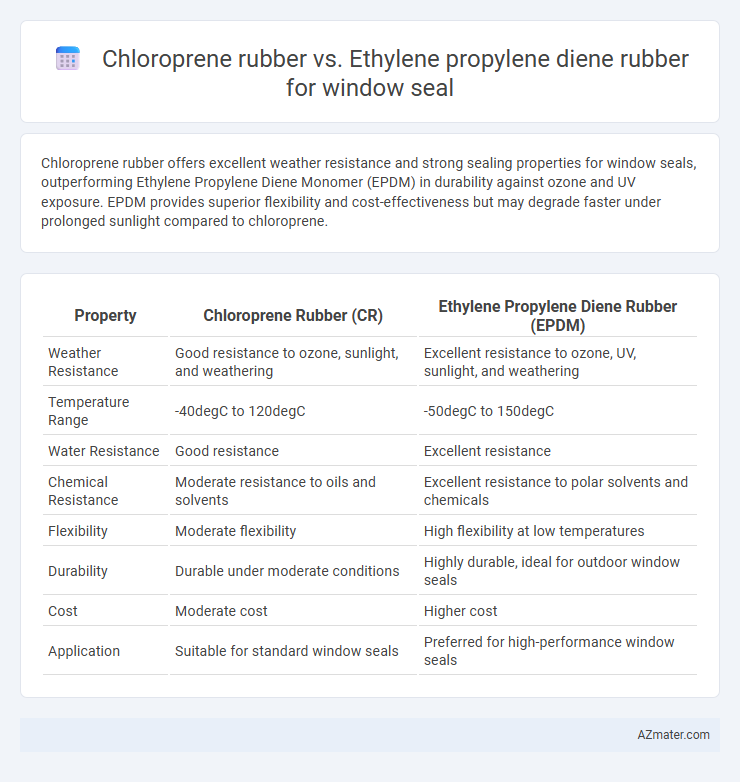Chloroprene rubber offers excellent weather resistance and strong sealing properties for window seals, outperforming Ethylene Propylene Diene Monomer (EPDM) in durability against ozone and UV exposure. EPDM provides superior flexibility and cost-effectiveness but may degrade faster under prolonged sunlight compared to chloroprene.
Table of Comparison
| Property | Chloroprene Rubber (CR) | Ethylene Propylene Diene Rubber (EPDM) |
|---|---|---|
| Weather Resistance | Good resistance to ozone, sunlight, and weathering | Excellent resistance to ozone, UV, sunlight, and weathering |
| Temperature Range | -40degC to 120degC | -50degC to 150degC |
| Water Resistance | Good resistance | Excellent resistance |
| Chemical Resistance | Moderate resistance to oils and solvents | Excellent resistance to polar solvents and chemicals |
| Flexibility | Moderate flexibility | High flexibility at low temperatures |
| Durability | Durable under moderate conditions | Highly durable, ideal for outdoor window seals |
| Cost | Moderate cost | Higher cost |
| Application | Suitable for standard window seals | Preferred for high-performance window seals |
Introduction to Window Seal Materials
Chloroprene rubber (CR) and Ethylene Propylene Diene Monomer (EPDM) are prominent materials in window seal applications due to their excellent weather resistance and elasticity. CR offers superior oil, ozone, and abrasion resistance, making it ideal for seals exposed to harsher environmental conditions. EPDM provides outstanding resistance to UV radiation, heat, and aging, delivering long-term durability and flexibility essential for maintaining airtight and waterproof window seals.
What is Chloroprene Rubber (CR)?
Chloroprene Rubber (CR), commonly known as Neoprene, is a versatile synthetic elastomer valued for its excellent weather, ozone, and chemical resistance, making it ideal for window seals exposed to outdoor conditions. Compared to Ethylene Propylene Diene Monomer (EPDM) rubber, CR offers superior oil and solvent resistance, enhancing durability in environments where such exposures occur. Its balanced mechanical strength and flexibility ensure an effective seal against air and water infiltration, crucial for maintaining window insulation and longevity.
What is Ethylene Propylene Diene Rubber (EPDM)?
Ethylene Propylene Diene Monomer (EPDM) rubber is a highly durable synthetic elastomer commonly used for window seals due to its excellent resistance to weathering, ozone, UV rays, and extreme temperatures ranging from -40degC to 150degC. Compared to Chloroprene rubber, EPDM offers superior flexibility and long-term sealing performance in outdoor applications, preventing water and air infiltration effectively. Its chemical structure, characterized by saturated hydrocarbon chains with diene monomers, enhances its elasticity and resistance to oxidation, making EPDM the preferred choice for weatherproof window seals.
Chemical Resistance: CR vs EPDM
Chloroprene rubber (CR) exhibits superior chemical resistance compared to Ethylene Propylene Diene Monomer (EPDM), particularly against oils, fuels, and solvents, making it more suitable for window seals exposed to automotive or industrial environments. EPDM excels in resistance to weathering, ozone, and water but is vulnerable to hydrocarbons and petroleum-based chemicals, limiting its use in chemically aggressive conditions. For window seals requiring robust protection against chemical degradation, CR offers enhanced durability and longevity.
Weatherability and UV Stability Comparison
Chloroprene rubber (CR) exhibits superior weatherability and UV stability compared to Ethylene Propylene Diene Monomer (EPDM) for window seals, maintaining elasticity and resistance to ozone and sunlight exposure over prolonged periods. EPDM offers excellent resistance to UV radiation but can degrade faster than CR when exposed to harsh environmental conditions involving ozone and certain chemicals. CR's molecular structure enables enhanced durability against cracking and discoloration, making it preferable for demanding weather-exposed applications.
Temperature Range Performance
Chloroprene rubber (CR) offers a temperature range of approximately -40degC to 120degC, maintaining flexibility and weather resistance ideal for window seals in moderate climate conditions. Ethylene propylene diene monomer rubber (EPDM) excels with a wider temperature tolerance from -50degC to 150degC, providing superior performance in extreme heat and cold environments. EPDM also demonstrates exceptional UV, ozone, and weather resistance, making it the preferred choice for durable, long-lasting window sealing solutions.
Mechanical Properties and Durability
Chloroprene rubber (CR) exhibits superior tensile strength and excellent resistance to weathering and ozone, making it highly durable for window seal applications. Ethylene propylene diene monomer (EPDM) rubber offers exceptional elasticity, outstanding resistance to heat, UV radiation, and aging, which enhances long-term performance in variable climates. For window seals, CR provides better mechanical robustness, while EPDM ensures enhanced flexibility and durability under extreme environmental conditions.
Cost and Availability Analysis
Chloroprene rubber (CR) offers moderate cost with widespread availability, making it a common choice for window seals requiring good weather resistance and moderate durability. Ethylene propylene diene rubber (EPDM) generally comes at a higher cost but provides superior UV, ozone, and weather resistance, resulting in longer service life for outdoor window seals. Market availability of EPDM can be more limited compared to CR, especially in specific formulations, impacting procurement decisions based on volume and budget constraints.
Typical Applications in Window Sealing
Chloroprene rubber (CR) is widely used in window seals due to its excellent weather resistance, flexibility, and durability, making it ideal for exterior applications exposed to sunlight and ozone. Ethylene propylene diene rubber (EPDM) excels in window sealing for its superior resistance to UV rays, ozone, heat, and aging, ensuring long-lasting performance in harsh environmental conditions. Both CR and EPDM provide effective sealing against air and water infiltration, but EPDM is often preferred for its enhanced elasticity and resistance to environmental degradation in window frames.
Choosing the Right Rubber for Your Window Seals
Chloroprene rubber offers excellent weather resistance and good flexibility, making it suitable for window seals exposed to moderate environmental conditions. Ethylene propylene diene rubber (EPDM) provides superior resistance to UV rays, ozone, and extreme temperatures, ideal for window seals in harsh outdoor environments. Selecting the appropriate rubber depends on the specific climate exposure and durability requirements of your window seals.

Infographic: Chloroprene rubber vs Ethylene propylene diene rubber for Window seal
 azmater.com
azmater.com